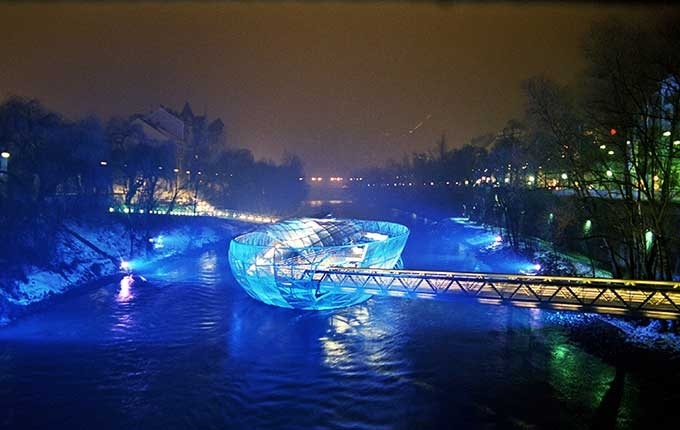Vito Acconci Thinking Space
–
Vito Acconci Thinking Space marks the 30th anniversary of Acconci’s winter-term residency on campus and the 1983 construction of Way Station I (Study Chamber), the artist’s first permanent commission. An internationally celebrated performance and video artist before he came to Middlebury, Acconci went on to found Acconci Studio and has subsequently maintained an active and distinguished career as a designer of public places in this country and abroad.
Acconci Studio projects include retail stores, airport terminals, apartment house complexes, waste disposal and water filtration plants, New York City subway stations, civic art centers, and community recreation facilities, among many other private and public constructions. The work of the artist himself has been the subject of numerous retrospective exhibitions at institutions abroad and including the Chicago Museum of Contemporary Art (1980) and The Museum of Modern Art, New York (1988) in this country. The most recent complete survey of Acconci’s career, Vito Hannibal Acconci Studio, was held in 2004 and 2005 at the Musee des Beaux-Arts de Nantes, France, and at the Barcelona Museu d’Arte Contemporani. During the most recent Venice Biennale Acconci was the subject of an exhibition at the Palazzo Pesaro Papafava. In December Acconci Studio was awarded the 2012 Miami Design District Award for Outstanding Accomplishment.
Although educated at The College of the Holy Cross, in Worcester, Massachusetts and awarded a Master of Fine Arts degree in literature and writing at the University of Iowa in 1964, Acconci is an unmistakable New Yorker. He was born in the Bronx and has maintained a studio in DUMBO, in Brooklyn, for some forty years. He is currently on the art faculty of Brooklyn College of the City University of New York and at Pratt Institute, in the Graduate Architecture and Urban Design Program.
The Museum exhibition, which focuses on several of the artist’s best-known projects, accompanies and inaugurates the reconstructed Way Station on the Middlebury Campus. At the urging of Museum Director Richard Saunders and the College’s Committee on Art in Public Places, the work, which was destroyed in 1985, has been replicated in a site adjacent to the Mahaney Center for the Arts. Making use of the steel shell of the original—once placed on a pathway between what is now Ross Commons and the Freeman International Center, near the site where McCardell Bicentennial Hall now stands—the reconstruction provides the College an opportunity to evaluate and assess its own part in Acconci’s transformation from performance artist to architect/designer.

Vito Acconci, Mur Island, Graz, Austria, 2003, Theatre, Café and Playground; curved seating; canopy.
At the time of its completion in the spring of 1983, the artist had not yet built a permanent work of art. Destruction of the piece deprived the community of a significant landmark in its own history, as Middlebury now houses a superb public art collection, one that has been inspired, in part, by the brief presence on the campus of Acconci’s structure. Comprising some twenty works, including sculptures by Tony Smith, Michael Singer, Joseph Beuys, and Jonothan Borofsky, and the Davis Library mural by Matt Mullican, the CAPP collection, of which Acconci’s reconstructed Way Station is now a part, is overseen and maintained by the Museum. It can be viewed on the College website at http://www.middlebury.edu/arts/campus.
Vito Acconci Thinking Space was organized by Chief Curator Emmie Donadio in consultation with the artist. With the collaboration of Museum Designer Ken Pohlman, who has overseen construction of the replica, the exhibition contextualizes the 1983 work in the broad scope of Acconci’s career. It surveys some fifteen projects—a minute fraction of those completed by the studio since its founding in 1988. Also included in the exhibit is a YouTube video demonstrating the artist’s temporary “deployable” Instant House (1980). Like many of his pieces in the era of Way Station, Instant House was installed inside an art museum, and it required a viewer/participant to activate and erect it. By contrast, Way Station I (Study Chamber) was intended to exist in the landscape and to be available as a temporary shelter for any passer-by.
In addition to architectural projects, Acconci Studio has designed clothing, automobiles, and Alessi serving utensils. In the artist’s view, architecture is a broad category that includes clothing, transportation systems, utilitarian objects, and future uses that have not yet been defined. As stated in the publication accompanying the Miami Design project last year, the Studio is “committed to an architecture that couldn’t have been built, couldn’t have been designed, couldn’t even have been imagined, before the 21st century.”
In conjunction with the exhibition, Acconci will return to campus as Cameron Visiting Architect. He will meet with students in the Programs in Studio Art and Architectural Studies and will give an illustrated talk, free and open to the public, in Dana Auditorium on Thursday, November 7, at 7 p.m. In addition to the Cameron funds, his visit is sponsored by the Museum, the Committee on Art in Public Places, the Department of History of Art and Architecture, and the Programs in Studio Art and Architectural Studies.
A publication recounting the history of Middlebury’s Way Station I (Study Chamber), available through the museum store, accompanies the exhibition and marks the replication of the sculpture. Vito Acconci Thinking Space will remain on view in the Museum’s Overbrook Gallery through Sunday, December 8.

![obanion_acconci_interview_vimeo_still.jpg]](/museum/sites/default/files/styles/1136x639/public/stories/obanion_acconci_interview_vimeo_still.jpg%5D?fv=yCVTnsIi&itok=Cw63nvAL)